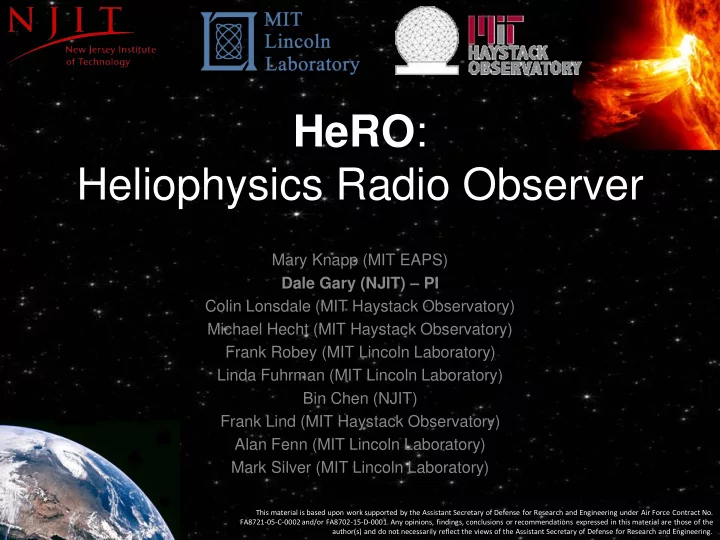

HeRO : Heliophysics Radio Observer Mary Knapp (MIT EAPS) Dale Gary (NJIT) – PI Colin Lonsdale (MIT Haystack Observatory) Michael Hecht (MIT Haystack Observatory) Frank Robey (MIT Lincoln Laboratory) Linda Fuhrman (MIT Lincoln Laboratory) Bin Chen (NJIT) Frank Lind (MIT Haystack Observatory) Alan Fenn (MIT Lincoln Laboratory) Mark Silver (MIT Lincoln Laboratory) This material is based upon work supported by the Assistant Secretary of Defense for Research and Engineering under Air Force Contract No. FA8721-05-C-0002 and/or FA8702-15-D-0001. Any opinions, findings, conclusions or recommendations expressed in this material are those of the author(s) and do not necessarily reflect the views of the Assistant Secretary of Defense for Research and Engineering.
HeRO : He liophysics R adio O bserver Key Questions • What are the shapes and properties of CME shock fronts? • What are the sites and conditions for efficient particle acceleration in coronal and interplanetary shocks? • What is the topology of magnetic fields from the sun into the heliosphere? Tracking type II and type III radio bursts with high temporal and spatial resolution across a wide range of frequencies Figure credit: Bin Chen
A Hybrid Instrument Space + Ground 300 Ground MHz Space 100 kHz Cane H V et. al. 2002 Solar flares, type III radio bursts, coronal mass ejections, and energetic particles J. Geophys. Res. 107 1315
HeRO-G • Based on RAPID – R adio A rray of P ortable I nterferometric D etectors • 15 – 300 MHz • Self-contained units with antenna, amps, receiver, data storage, power • 25 units per HeRO-G station (300 baselines) • 2 HeRO-G stations widely separated in longitude for > 60% temporal coverage HeRO-G Integrated Unit Prototype
HeRO-S • 6 CubeSats (6U) – 15 baselines • 100 kHz – 20 MHz • Baselines 500 m – 10 km • Near-geosynchronous orbit • Voltage data stored in ring buffer onboard, correlated and post- processed on the ground
Vector Sensing • 3 dipoles + 3 loops (electrically small) • Measures full E and B field vectors, ExB = S (Poynting vector) • Determines sources’ intensity, direction and polarization in single snapshot • Typically used for finding direction of strong sources • Additional degrees of freedom when compared to triad/tripole The vector sensor enables • More sensitive (≥2x), capable nulling of interfering element than tripole for sources interferometric arrays
CubeSat Deployable Vector Sensor Deployed Monopole Loop/dipole 2 (2 m) Telescoped Loop 3 Stowed Spacecraft bus 7
Deployable Vector Sensor Prototype 8
High Altitude Balloon Test (Single Vector Sensor) Balloon-mounted Results: ~3 ° direction of arrival vector sensor tracked angle of arrival of test accuracy beacon on the ground Direction of arrival (azimuth) vs. time Red: Truth Blue: Vector sensor measurement
Summary • HeRO is a hybrid space + ground heliophysics observatory • HeRO will generate a rich multidimensional dataset on type II and III bursts • High temporal, spatial, and frequency resolution and full polarization information • Context measurements for upcoming solar missions (SPP, SO) • Potential for discovery – a new way to look at the sun
Acknowledgements HeRO collaboration: Dale Gary (PI), Colin Lonsdale, Frank Robey, Mike Hecht, Linda Fuhrman, Bin Chen, Mary Knapp, Frank Lind, Ryan Volz, Alan Fenn, Alex Morris, Mark Silver, Kerry Johnson, Divya Oberoi, Juha Vierinen, Sarah Klein, Sara Seager, Fash Azad, Will Rogers, Tom Brown Generous support provided by the Lincoln Laboratory Advanced Concepts Committee
Recommend
More recommend